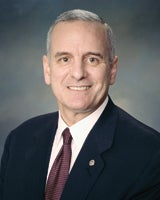‘Buffer bully’? Dayton embraces title in water push
Published 10:17 am Wednesday, May 6, 2015
ST. PAUL — Gov. Mark Dayton has been labeled “the buffer bully” and run into severe resistance with a plan requiring farmers to leave more space between cropland and sensitive waterways.
But as Minnesota’s legislative session reaches its crescendo, Dayton said he’s not about to relent. And, he told The Associated Press on Tuesday, people can expect him to charge hard on water quality issues as he seeks a legacy on that front in his second and final term. This year the focus is buffer strips, but steps to improve drinking water and wastewater treatment plants are already on his radar.
“We have a whole range of things here related to water quality. It’s going to be on the top of my agenda for the next three and a half years,” Dayton said in an interview. “I wish I picked up on it four years ago. But better late than never.”
Immediately after AP’s afternoon interview, Dayton was convening representatives of agriculture groups to push them toward a buffer-strip deal. He said he’s willing to compromise on a proposal to require 50-foot buffers around all waterways, which advocates say are needed to help filter farm runoff that threatens clean water with chemicals and sediment. He acknowledged that passage of a legislative proposal depends on buy-in from farmers, but he said he’ll go toe-to-toe with them to ensure any plan protects Minnesota’s lakes, rivers and streams.
“I’m going to be able to do what most politicians can’t do in a farm state, which is to take on some of the agriculture interests,” he said. “It’s the kind of issue I can take on for the next four years now that I’m not running for election.”
It’s a heartening sound to environmental groups, whose leaders said they had trouble recalling the last governor to place such an emphasis on water quality.
“He’s not just talking about the problem and doing some things that are window dressing,” said Steve Morse at the Minnesota Environmental Partnership. “He’s cutting new ground.”
Livestock farmer Paul Sobocinski, an organizer for the Land Stewardship Project, said Dayton’s demands aren’t unreasonable.
“A 50-foot buffer is not something to have a heart attack over,” Sobocinski, who also grows corns, soybeans and other crops on his plot in Wabasso. “We benefit as farmers ourselves by improving water quality. We drink the water out here, too.”
The agriculture industry isn’t buckling under the governor’s pressure.
Dayton’s comments about farmers and water quality “make it seem like we’re not doing anything besides just dumping a bunch of stuff in the river, which isn’t true at all,” said Adam Czech, spokesman for the Minnesota Corn Growers Association.
“It’s a little bit unfortunate that he feels the need to take us on, I guess,” Czech said, noting that many farmers support and already use some kind of buffer.
Dayton has softened his tone on farmers’ responsibility for poor water quality earlier this year after those groups labeled his buffer plan as an unworkable, one-size-fits-all land grab. He said Tuesday he’s not wedded to that large of a setback and conceded “all farms are different.”
But prior to his farm-group meeting at the Governor’s Residence, Dayton insisted farmers can’t shirk their responsibility to reduce pesticides and other runoff. That, he said, could put a final deal beyond this legislative session.
If nothing else, Dayton said he’s managed to put an issue that had been on the back burner into fuller view. It’s an issue that even the governor admits Minnesota residents might not automatically connect with agriculture.
The state’s pollution control agency released a report last week showing that water quality is degrading across the state, particularly in farm-filled southern Minnesota. Dayton and his health department will follow up Wednesday with a status check on the state of Minnesota’s drinking water.
Going forward, Dayton signaled plans to tackle a backlog of more than $1 billion in upgrades at wastewater treatment facilities and infrastructure statewide.
“If you were told you can’t take your kids into this body of water because it’s contaminated it certainly drives the point home,” the governor told AP. “If you don’t catch any fish because they can’t live in that body of water it certainly drives the point home.”






